Nacreous Clouds UK & Ireland - OPOD
Nacreous Clouds: A Spectacular Atmospheric Phenomenon in the UK & Ireland
Nacreous clouds, also known as polar stratospheric clouds (PSCs), continue to grace the skies of Ireland and the UK with their breathtaking beauty. These rare cloud formations are visible during both morning and daytime, thanks to the persistently low temperatures in the stratosphere. As the sun sets, the true magnificence of nacreous clouds becomes apparent, as they adorn the sky with a stunning array of colors.
If you're fortunate enough to witness these mesmerizing clouds, take a moment to observe the entire sky between 15 to 45 minutes after sunset. Although the pictures provided give a glimpse of their filmy appearance, the reality is even more captivating. Nacreous clouds are wave clouds, characterized by their thin sheets that gracefully stretch and curl in the winds of the stratosphere.
During daylight hours, spotting nacreous clouds can be a challenge due to their muted colors and subtle presence. However, with a keen eye and a bit of patience, you may be rewarded with the sight of these ethereal clouds lingering almost motionless in the sky. And when night falls, these seemingly dormant clouds burst forth with vibrant hues, creating a spectacle that is truly awe-inspiring.
It's important to note that the images displayed in this article may not appear as intended due to the conversion from the old site. For the original article, please visit here.
The Science Behind Nacreous Clouds
Nacreous clouds form in the stratosphere, a layer of Earth's atmosphere located between 10 and 50 kilometers above the surface. Unlike most clouds that form in the troposphere, where weather occurs, nacreous clouds develop much higher up in the atmosphere. Their formation is closely tied to extremely low temperatures, typically below -78 degrees Celsius (-108 degrees Fahrenheit), which are only found in the polar regions during winter.
These frigid temperatures cause water vapor and other atmospheric particles to freeze into ice crystals. However, what sets nacreous clouds apart is the unique composition of these ice crystals. They contain a mixture of water and nitric acid, forming a type of cloud known as Type II PSCs. This combination of ingredients gives nacreous clouds their distinctive iridescent appearance, as sunlight interacts with the ice crystals, scattering light in different directions and producing a stunning display of colors.
The Beauty of Nacreous Clouds
Nacreous clouds are renowned for their vibrant and ever-changing colors. As sunlight filters through the icy particles within these clouds, it undergoes a process called diffraction, which causes the light to split into its constituent colors. This phenomenon is similar to what occurs when light passes through a prism. The result is a breathtaking display of pastel hues, ranging from delicate pinks and purples to vivid oranges and blues.
The delicate nature of nacreous clouds adds to their allure. Unlike their lower-altitude counterparts, which are often thick and dense, nacreous clouds possess a translucent quality that gives them an ethereal appearance. Their thin sheets gently undulate in the stratospheric winds, creating a mesmerizing dance across the sky. The interplay between light, ice crystals, and atmospheric conditions makes nacreous clouds a truly enchanting sight to behold.
The Rarity and Geographic Distribution
Nacreous clouds are considered one of the rarest cloud formations on Earth. Due to their specific requirements for formation, they are typically confined to high-latitude regions near the poles during winter. This means that sightings of nacreous clouds in the UK and Ireland are relatively infrequent and highly sought after by both amateur and professional photographers.
The geographic distribution of nacreous clouds is largely influenced by the polar vortex, a persistent circulation pattern that forms during winter in the polar regions. This atmospheric phenomenon creates a stable and isolated environment in the stratosphere, allowing the necessary conditions for nacreous cloud formation to occur. As a result, countries such as Norway, Sweden, Iceland, and the UK often have the privilege of witnessing these stunning displays of nature's artistry.
The Importance of Studying Nacreous Clouds
Beyond their aesthetic appeal, nacreous clouds play a significant role in atmospheric science. These unique cloud formations provide valuable insights into the composition and dynamics of the stratosphere. By studying nacreous clouds, scientists can gain a better understanding of the complex interactions between atmospheric gases, particles, and temperature variations at high altitudes.
Furthermore, nacreous clouds have been linked to the depletion of ozone in the stratosphere. The presence of nitric acid within these clouds can lead to chemical reactions that contribute to the destruction of ozone molecules. Therefore, monitoring and studying nacreous clouds can help researchers assess the impact of human activities on the ozone layer and develop strategies for its protection.
Capturing the Magic: Photographing Nacreous Clouds
For photographers and sky enthusiasts alike, capturing the beauty of nacreous clouds can be a rewarding challenge. To increase your chances of photographing these elusive clouds, consider the following tips:
- Choose a location with an unobstructed view of the horizon, allowing you to observe the entire sky.
- Use a tripod to stabilize your camera and reduce blur caused by long exposures.
- Experiment with different camera settings, such as longer exposure times and lower ISO values, to capture the delicate colors and details of the clouds.
- Be patient and persistent. Nacreous clouds may appear suddenly and disappear just as quickly, so be prepared to seize the moment when they grace the sky.
Remember, witnessing nacreous clouds is a rare privilege, so take the time to savor the experience and appreciate the wonders of our atmosphere.
In conclusion, nacreous clouds are a captivating atmospheric phenomenon that enchants observers with their delicate beauty and iridescent colors. Although relatively rare, these stunning cloud formations occasionally grace the skies of the UK and Ireland, creating a spectacle that is both awe-inspiring and scientifically significant. By studying and photographing nacreous clouds, we can deepen our understanding of the stratosphere and gain valuable insights into the delicate balance of our planet's atmosphere. So, keep your eyes on the sky and be ready to be amazed by the fleeting magic of nacreous clouds.
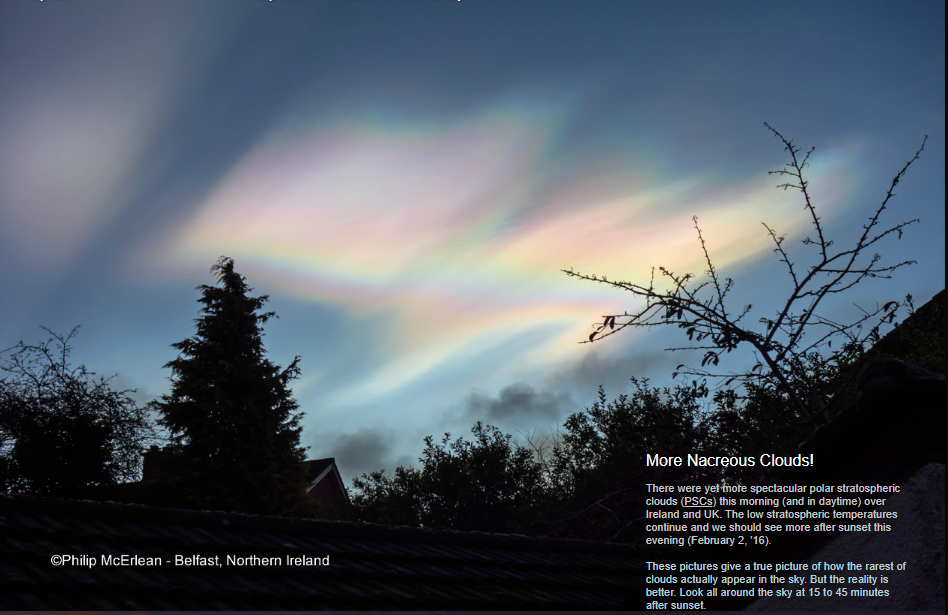
More Nacreous Clouds!
There were yet more spectacular polar stratospheric clouds (PSCs) this morning (and in daytime) over Ireland and UK. The low stratospheric temperatures continue and we should see more after sunset this evening (February 2, '16).
These pictures give a true picture of how the rarest of clouds actually appear in the sky. But the reality is better. Look all around the sky at 15 to 45 minutes after sunset.
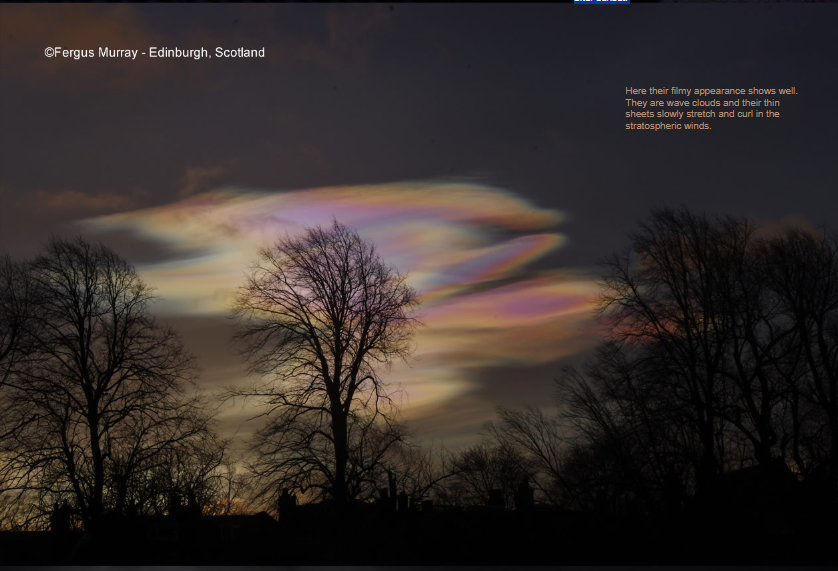
Here their filmy appearance shows well. They are wave clouds and their thin sheets slowly stretch and curl in the stratospheric winds.
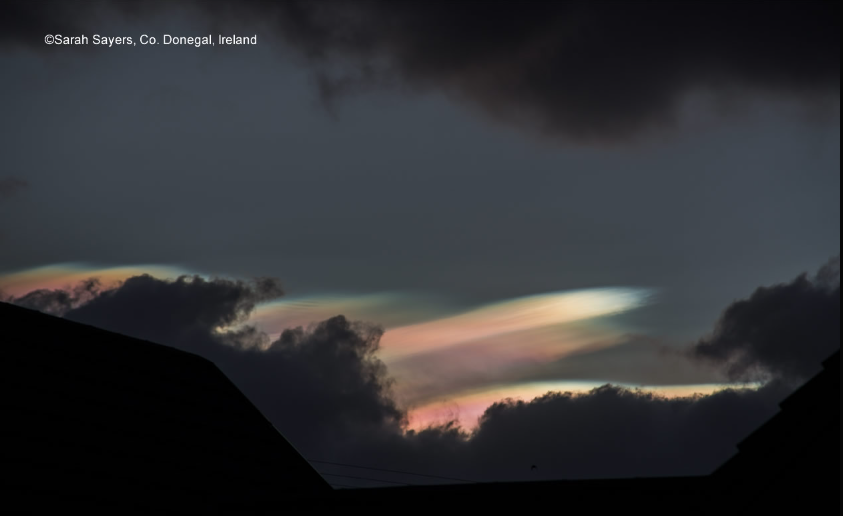

A daytime view. Muted colours and a keen eye needed to spot them but they wait there almost stationary to blaze forth colours after sunset.
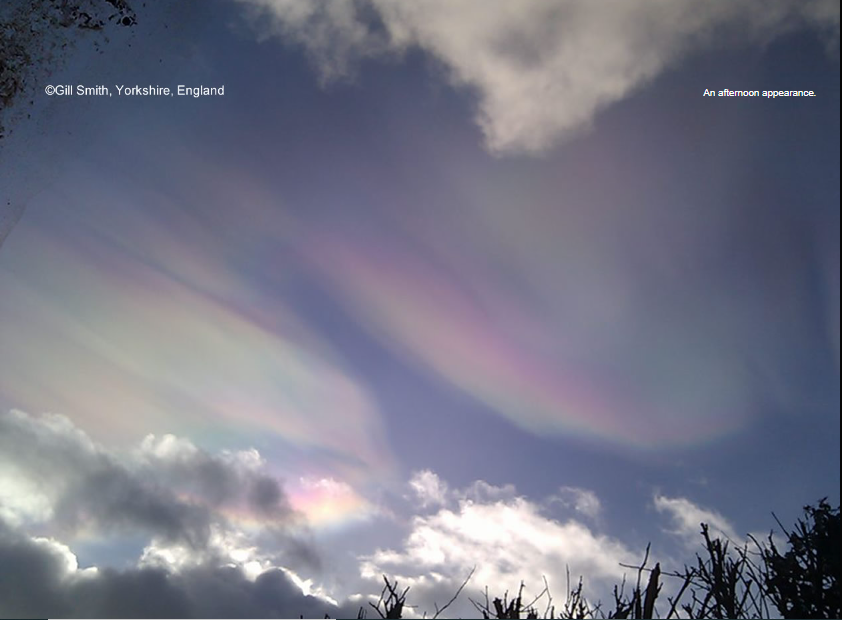
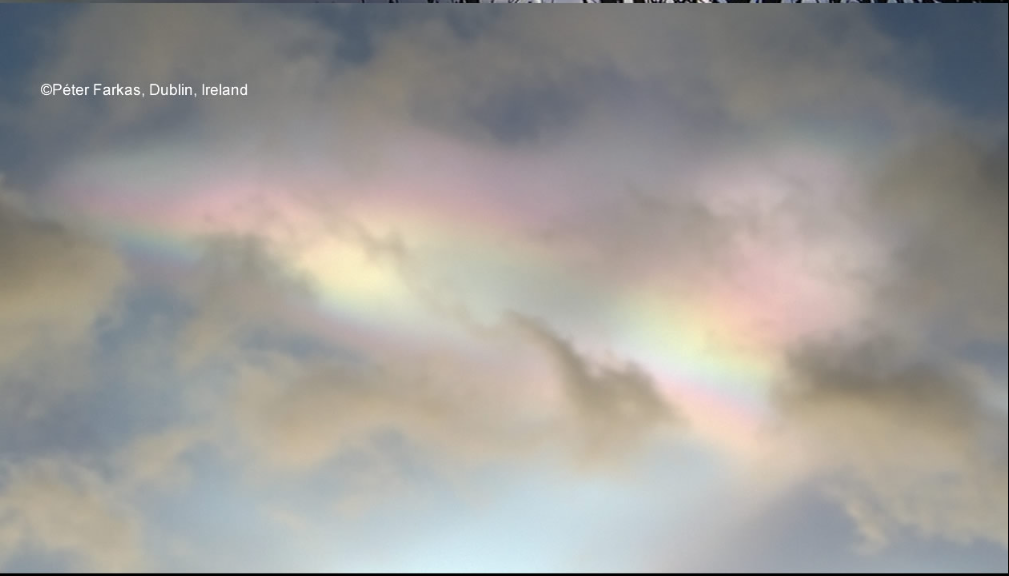
Note: this article has been automatically converted from the old site and may not appear as intended. You can find the original article here.
Reference Atmospheric Optics
If you use any of the definitions, information, or data presented on Atmospheric Optics, please copy the link or reference below to properly credit us as the reference source. Thank you!
-
<a href="https://atoptics.co.uk/blog/nacreous-clouds-uk-ireland-opod/">Nacreous Clouds UK & Ireland - OPOD</a>
-
"Nacreous Clouds UK & Ireland - OPOD". Atmospheric Optics. Accessed on November 26, 2024. https://atoptics.co.uk/blog/nacreous-clouds-uk-ireland-opod/.
-
"Nacreous Clouds UK & Ireland - OPOD". Atmospheric Optics, https://atoptics.co.uk/blog/nacreous-clouds-uk-ireland-opod/. Accessed 26 November, 2024
-
Nacreous Clouds UK & Ireland - OPOD. Atmospheric Optics. Retrieved from https://atoptics.co.uk/blog/nacreous-clouds-uk-ireland-opod/.